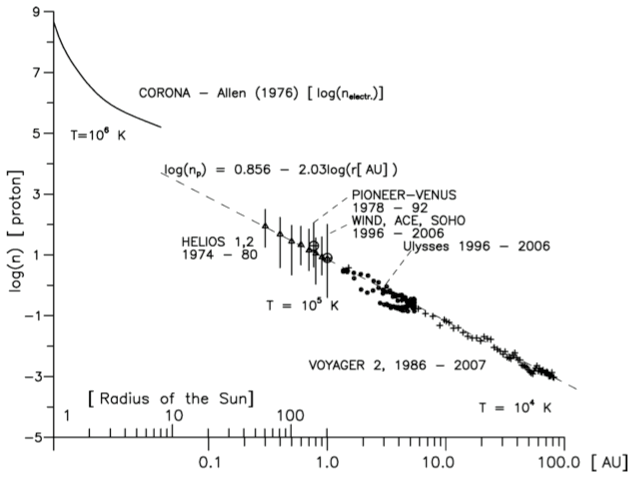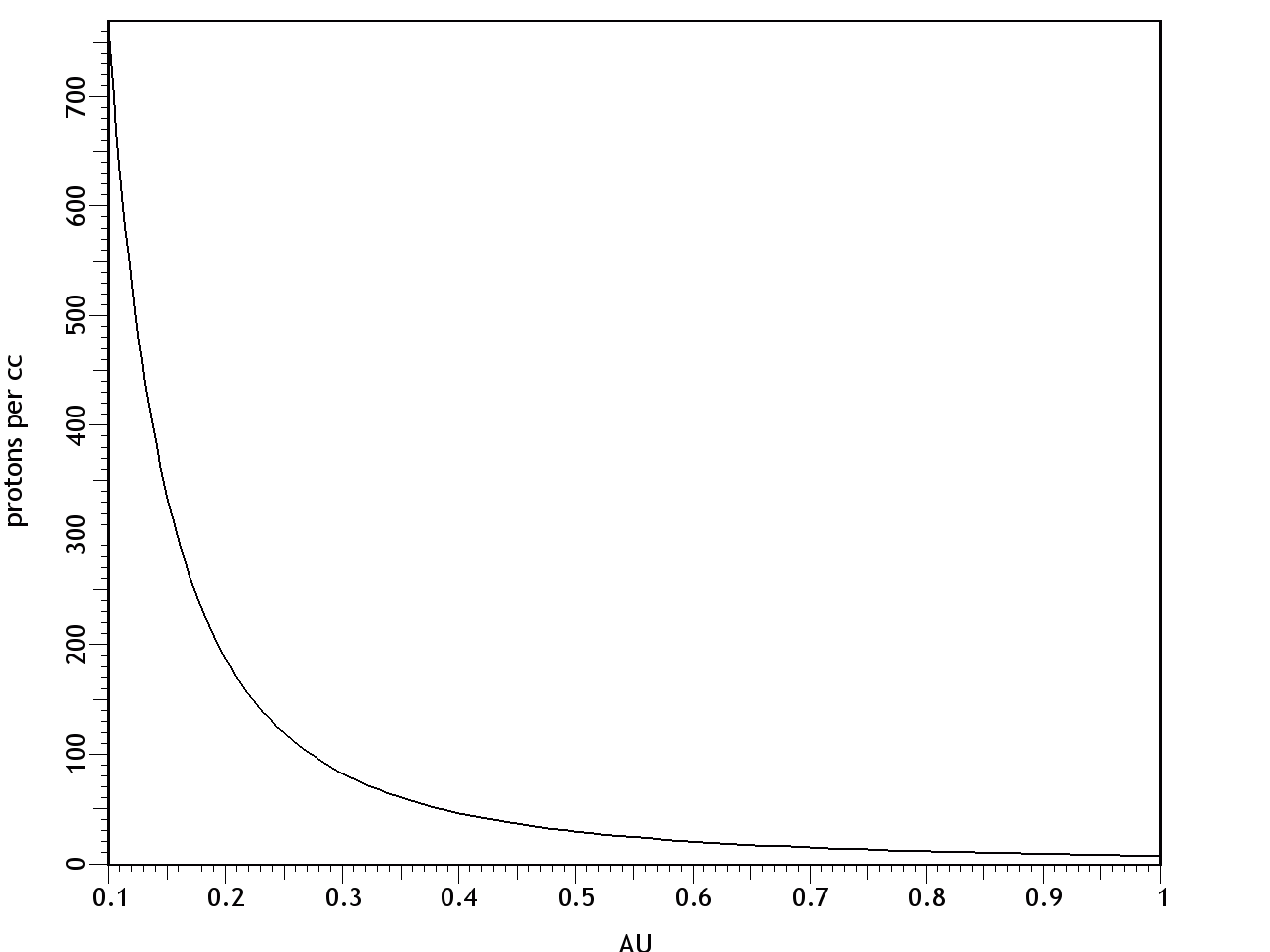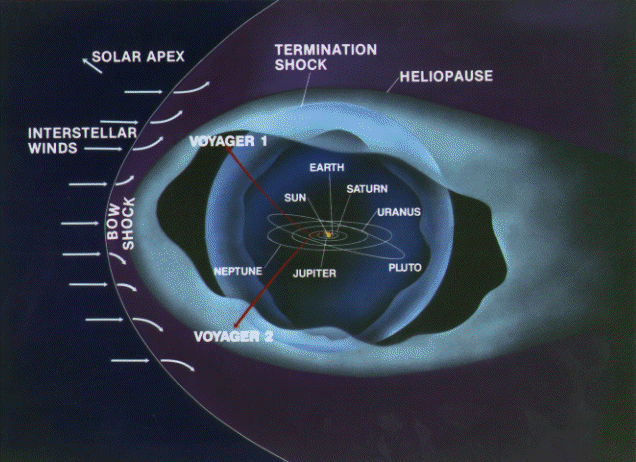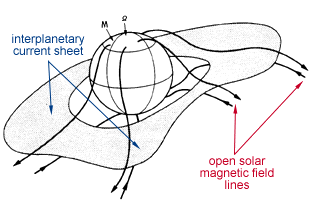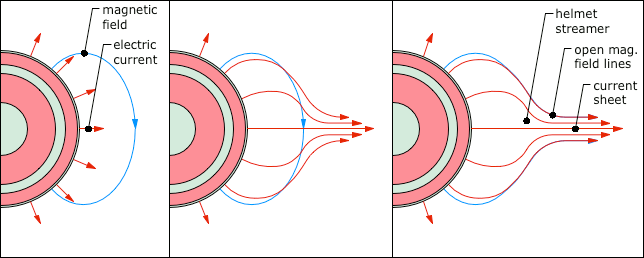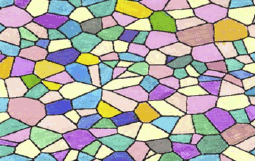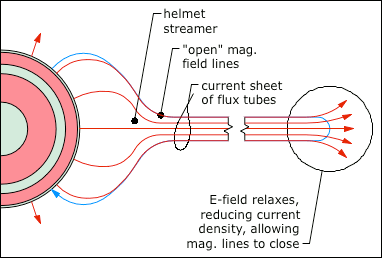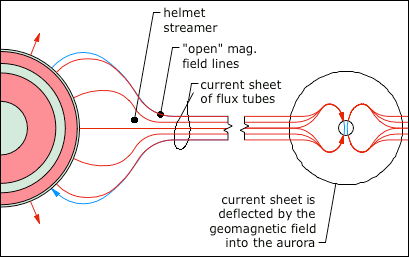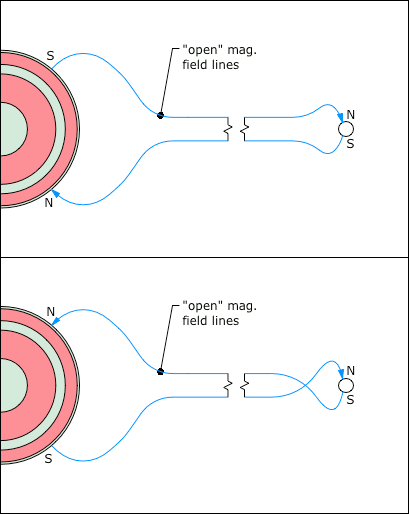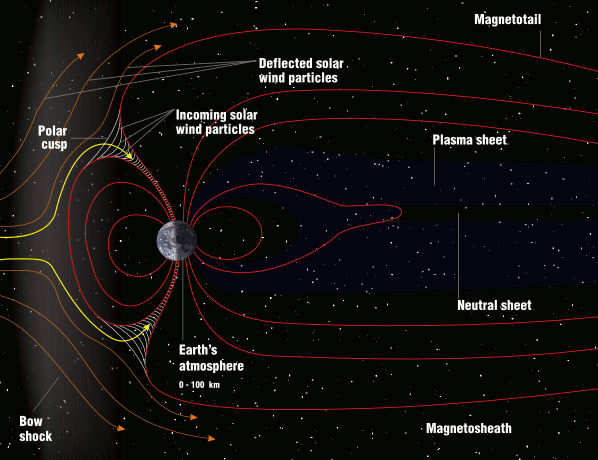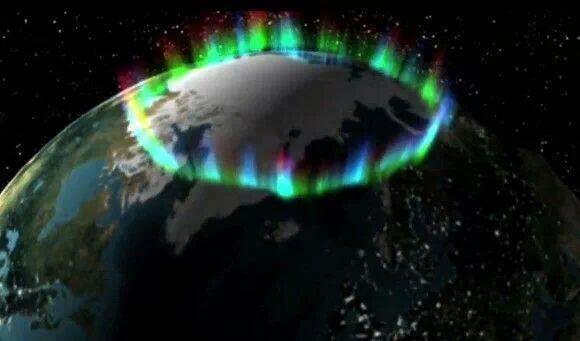© Charles ChandlerNow we should make a direct examination of the larger environment in which all of this is happening. The entire scope of the Sun's influence is known as the heliosphere, with the Sun at the center (of course), and with a radius of something like 1.50 × 1010 km. Aside from the Sun, the planets, moons, asteroids, and a few comets, the rest of it is a very diffuse plasma known as the interplanetary medium (IPM). (See Figure 1 and Figure 2.) With a total mass of just 3.53 × 1016 kg, if the IPM were compressed into a solid rock, it would have a radius of just 15 km.1Figure 1. Proton density (i.e., 95% of the constitution of the solar wind) in the interplanetary medium, courtesy Pintéra et al. (2009).Figure 2. Same as Figure 1, but with linear scales on both axes, showing that most of the density is near the Sun. At 100 AU, it's 6.25 × 10−4 protons/cm3.The standard model of the IPM is that it is a bubble being blown by the solar wind.2 When the bubble runs into the interstellar medium (ISM), the friction brings the solar winds to a stop, forming a "termination shock" that defines the principle extents of the Sun's influence. The interstellar winds, moving at only 23 km/s relative to the Sun, then slowly carry off excess plasma, creating an indistinct coma. (See Figure 3.)The part of the standard model that isn't correct is the termination shock. The slow solar wind expands at roughly 450 km/s. At that rate, it can traverse the 100 AU from the Sun to the heliopause in just 1.06 years. Surely the solar winds have been blowing for longer than just a year, so shouldn't the heliopause occur at 100 AU, times the number of years the solar winds have been blowing? Or if the ISM is forcing a hard stop, there should be a build-up of matter in the heliopause, equal to the existing density, times the number of years the solar winds have been blowing. If the Sun has been burning for a billion years, the heliopause should be a billion times thicker. But such a build-up of density in the heliopause doesn't exist, as data from Voyager I have shown. Rather, the density is greater beyond the heliopause,3 because the ISM is cooler and denser than the heliosphere, while inside the heliopause, as determined by chemical composition, magnetic fields, etc., the density follows the rule in Figure 1.Another form of analysis begs the same exact question — the total mass of the IPM is just 3.53 × 1016 kg, and with the mass of the solar wind being 3.15 × 1016 kg/yr,4:409,5 the solar wind should be able to populate the IPM to its current density in just 1.21 years. So if the Sun has been burning longer than that, where are all of the particles from years gone by? The interstellar winds, moving at only 23 km/s, won't be able to remove material being supplied by the solar wind at 450 km/s.So where does all of the mass in the solar wind go, if it isn't being whisked away by the interstellar winds, and if it isn't building up in a termination shock at the heliopause? It actually seems to be raining back down on the Sun.6,7 It's tough to see in the blinding light of charge streams excited to greater than 1 MK in the corona, but once neutralized, particles are free to fall back to the Sun due to the force of gravity, as long as they can stay out of the helmet streamers. In other words, the wind pressure isn't the same in all directions, and while the highly energetic outflow is easy to see, there is an equal-but-opposite inflow that gently recycles neutralized matter. Most of the density in the IPM is very near the Sun, as we can see in Figure 2, and which is due simply to the Sun's 274 m/s2 gravitational acceleration. So that's the 3.15 × 1016 kg/yr making its way back to the Sun.Away from the Sun, the boundary between the IPM and the ISM actually seems to be somewhat less dramatic of a transition than had been expected — there is some turbulence in the heliopause, and the magnetic fields flip every time the wind changes direction. But there is no termination shock. The IPM is hotter, and as a consequence it's less dense, while the ISM is cooler and more dense. Still, the ideal gas laws show that both are at roughly the same pressure (i.e., ~10−21 pascals). The IPM is a little less dense than it should be, but it also has a slight positive charge, meaning that electrostatic repulsion contributes to the hydrostatic pressure. Thus the IPM and the ISM are in equilibrium, just on the basis of temperature and charge, and without the need for any wind pressure to help maintain the bubble.The positive charge in the IPM begins with the ejection of +ions in CMEs. But at the heliopause, there appears to be another mechanism that increases the positive charge in the IPM. Recent research has demonstrated that when neutral interstellar atoms impinge on the heliosphere, the electrons are stripped off in particle collisions, while the +ions continue into the IPM due to their greater momenta.8,9 Electrostatic repulsion within the IPM then distributes the positive charges. So when CMEs eject +ions out into the IPM, they are simply adding to an existing positive charge there, and the electrons flowing out of the Sun to re-establish charge equilibrium are attracted to the combined positive charge.Now we have the general context in which to fully understand the behavior of the electron streams coming out of the Sun. While CMEs are discrete events, the equal-but-opposite drift of electrons in response to the charge imbalance is a steady stream. Why don't the electrons respond instantaneously? First, the source of the electrons is a negative layer that is 20 Mm below the surface, so there is resistance to the flow of a current that regulates it. Second, the +ions in a CME, once away from the Sun, are quickly dispersed by their repulsion from each other, leaving just a little contribution to a broadly distributed field, instead of a stronger localized field. Third, the electric lines of force repel each other, further distributing the field. And lastly, the electrons are sitting on a current divider. They are at once attracted to an underlying layer of positive charge, and to the positive charge in the IPM, and a shift in that balance creates only a slight (but sustained) increase in voltage. This creates a sustained electron drift, even if the e.m.f. is episodic, analogous to a relatively steady flow through a dam's spillway, even if rainfall in the catchment area isn't steady, and the water level goes up and down quite a bit. Once the solar winds are liberated from the Sun's gravity and accelerated to 450 km/s, there is nothing to stop them until they reach the heliopause, though the density thins by the inverse square law due to the radial expansion. (See Figure 1.)Next, the heliospheric current sheet (HCS) should be considered. (See Figure 4.) Here we have a fair amount of data, but the standard interpretation makes little sense. Beginning at roughly 1.5 R⊙, there is a thin sheet of electric current propagating outward from the Sun. The total current at 1 AU has been estimated at 3.00 × 109 A.10 In the present model, we can easily accept that there is a current, but it's quite low compared to 2.93 × 1015 A estimated in the Conversions section. Yet this doesn't mean that something is wrong. CMEs expel +ions, motivating an outward electron drift. Once away from the Sun, the electrons are also attracted to the net positive charge in the IPM. So the electrons are driven by the electric force, and the +ions are driven by CMEs, hydrostatic pressure, and electron drag. At some point away from the Sun, the electrons will have caught up with the +ions, meaning no more current. Closer to the Sun, the electrons are still moving faster, registering as a negative current away from the Sun. Since the solar wind appears to still be accelerating at 1 AU,11,12,13:9:12 it makes sense that there is still some current, while only directly at the surface of the Sun would we expect the full 2.93 × 1015 A.The HCS is ridiculously thin, being roughly 10 Mm near the orbit of the Earth, which is thinner than the diameter of the Earth itself. What could keep a current like this organized? The standard model answers this with a riddle. While it is a fundamental law that magnets are always dipoles, astronomers maintain that the Sun has "open magnetic field lines" (or "magnetic flux tubes" as they are sometimes called) that project outward, and the HCS is sandwiched between "flux tubes" of opposite polarity. (See Figure 4.) So what's a "flux tube"? And what binds them together so that they can exert some sort of force on the HCS?To sort this out, we have to start back at the Sun. Figure 5 shows a progression of interactions that ultimately produce the helmet streamers, the open field lines, and the HCS.In the first panel, the electron drift away from the Sun is shown radiating in all directions, along with the typical magnetic field (during the quiet phase).The second panel shows the effect of the magnetic field on the electron drift — the current is deflected in the direction of the B-field, which converges toward the equatorial plane. Nearing the point of convergence, electrostatic repulsion between the electron streams deflects them outward, once again responding only to the attraction to +ions in the heliosphere.The third panel shows the final result, where the current is not only affected by the solar B-field, but modulates it as well. As a field-aligned current, the particles develop a spin. In the gradual transition from the solenoidal back to the radial path at the tips of the helmet streamers, the particles retain their angular momenta, and continue to generate their own magnetic fields. While the solenoidal field deflects the particles into field-aligned currents, it is also true that as the particles are pulled more and more away from the solenoidal form, the B-fields are deflected in the direction of the electron stream. This ultimately resolves into spinning particles streaming out into space, with axial B-fields inside Birkeland currents that have split the solenoid into "open field lines."Figure 5. The emergence of helmet streamers and the heliospheric current sheet from a radial current and a toroidal magnetic field.This explains the broad base of the helmet streamer, the narrow tip, the "open field lines" in the Birkeland currents, and to some extent, the current sheet in the middle of it all. But it also positions us for a new insight into the true nature of the current sheet. In the standard model, the "magnetic flux tubes" do not have associated electric currents, which is odd because only electric currents can generate magnetic fields. Then, there's the current sheet, which strangely doesn't have an associated magnetic field. The two riddles answer each other. The electric current that generates the magnetic fields in the "flux tubes" is the current sheet itself. Figuratively speaking, if we look closely at the "sheet," we find that it is made of threads, and the threads are Birkeland currents. So it's not that the oddly non-magnetic current is sandwiched between the oddly non-electric magnetic tubes, but rather, that the current through the many tubes constitutes the HCS.
1. Wikipedia (2017): Interplanetary Dust Cloud. ⇧
2. Dunbar, B. (2013): What defines the boundary of the solar system? nasa.gov ⇧
3. Landau, E. (2017): Voyager - The Interstellar Mission. nasa.gov ⇧
4. Carroll, B. W. (1996): An Introduction to Modern Astrophysics. Addison-Wesley Pub. ⇧
5. Noerdlinger, P. D. (2008): Solar Mass Loss, the Astronomical Unit, and the Scale of the Solar System. arxiv, 0801.3807 ⇧
6. Sheeley, N. R., Jr.; Wang, Y. (2001): Coronal Inflows and Sector Magnetism. The Astrophysical Journal Letters, 562 (1): L107 ⇧
7. Fleck, B. (2001): SOHO's latest surprise: Gas near the Sun heading the wrong way. ⇧
8. May, H. D. (2008): A Pervasive Electric Field in the Heliosphere. IEEE Transactions on Plasma Science, 36 (5): 2876-2879 ⇧
9. May, H. D. (2010): A Pervasive Electric Field in the Heliosphere (Part II). viXra, Astrophysics: 1005.0090 ⇧
10. Israelevich, P. L. et al. (2001): MHD simulation of the three-dimensional structure of the heliospheric current sheet. Astronomy & Astrophysics, 376: 288-291 ⇧
11. Phillips, J. L. et al. (1995): Ulysses solar wind plasma observations from pole to pole. Geophysical Research Letters, 22 (23): 3301-3304 ⇧
12. Cranmer, S. R. (2009): Testing and Refining Models of Slow Solar Wind Acceleration. SHINE 2009 Workshop ⇧
13. Johnson, R. (2013): The Nature of the Sun Revisited. Electric Universe Conference (Albuquerque) ⇧
14. Borovsky, J. E. (2008): Flux tube texture of the solar wind: Strands of the magnetic carpet at 1 AU? Journal of Geophysical Research: Space Physics (1978–2012), 113 (A8) ⇧ ⇧ ⇧
15. O'Carroll, C. (2012): NASA Spacecraft Make New Discoveries About Northern Lights. NASA ⇧
16. Arnold, L.; Li, G.; Li, X.; Yan, Y. (2013): Observation of flux tube crossings in the solar wind. arXiv, astro-ph.SR: 1304.1925 ⇧
17. Davis, N. (1992): The Aurora Watcher's Handbook. University of Alaska Press ⇧
18. Evans, D. S. (1975): Evidence for the Low Altitude Acceleration of Auroral Particles. Pgs 319-341 in "Physics of Hot Plasma in the Magnetosphere." Proceedings of the Thirtieth Nobel Symposium ⇧
19. Goodman, J. (2014): What is the total net charge of the earth's surface? MadSci Network: Earth Sciences ⇧
Pintéra, T.; Dorotoviča, I.; Rybanský, M. (2009): The heliosphere mass variations: 1996–2006. Proceedings of the International Astronomical Union, 4 (257): 291-293











